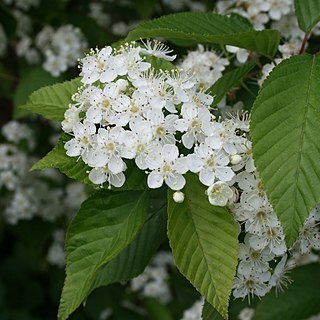Trees to 20 m tall. Branchlets dark reddish brown when young, dark grayish brown when old, terete, puberulent when young, glabrous when old, with white lenticels; buds ovoid, 4–7 mm, apex acute; scales several, dark reddish brown, glabrous. Leaves simple; petiole 1.5–3 cm, glabrous or slightly puberulent; leaf blade ovate to elliptic-ovate or suborbicular, 5–10 × 3–6 cm, lateral veins 6–10(–14) pairs, nearly parallel and terminating in marginal teeth, raised abaxially, both surfaces glabrous or abaxially puberulent along veins, base broadly cuneate to rounded, margin irregularly sharply doubly serrate or lobed, apex shortly acuminate. Compound corymbs terminal, 4–8 cm in diam., loosely 6–25-flowered; rachis and pedicels sparsely pubescent. Pedicel 6–12 mm. Flowers 1–1.4(–1.8) cm in diam. Hypanthium campanulate, abaxially glabrous. Sepals triangular or triangular-ovate, apex acute. Petals white, suborbicular to oblong-ovate, 5–7 × 3.5–6 mm, base clawed, apex obtuse. Stamens 20; filaments white, slightly shorter than petals. Ovary 2-loculed; styles 2, not exceeding stamens, glabrous, connate basally. Fruit red, oblong, ovoid-oblong, or globose, 1–1.4 cm × 7–10 mm, without or with few minute lenticels, sepals caducous, leaving a small annular scar; seeds pale brownish orange, linear-oblong. Fl. Apr–May, fr. Aug–Sep.
More
A deciduous tree. It grows 20 m tall. It is a broad cone shape. The bark is dark brown and smooth. It has shallow cracks. The leaves are oval and 10 cm long by 4 cm wide. They are pointed and have teeth along the edge. They are dark green and downy above and become smooth underneath. They turn yellow, orange or red in autumn. The flowers are 1 cm across and white. They occur in clusters. The fruit is rounded and yellow or red. They are 1 cm across.
Slopes of shady mountain forests of stone pine and deciduous trees on stony and humus rich soils. Slopes, gullies, mixed forests and shrubby thickets; at elevations from 500-2,400 metres.
More
A temperate plant. It is native to China, Japan, Korea and Taiwan. It grows in woods between 500-2,300 m above sea level. It suits hardiness zones 6-9. In Sichuan.
Can be grown by cuttings, graftings or seedlings. Seeds needs stratification.


